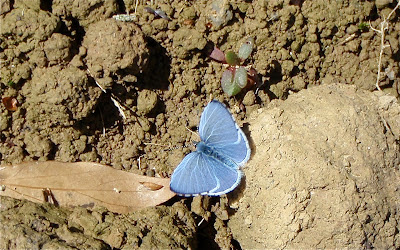Today the scudding clouds were chasing in from the frozen north with the sun providing little warmth when it did appear - birds were using the shelter provided by the steep river banks.
Oak leaves appearing
The old Oaks are at last bursting into leaf in the sunshine - ahead of the Ash trees this spring.
A bright sunny start after a frosty night but the north wind strengthening with fewer and fewer glimpses of the sun as the morning disappeared. The river banks greening up with hawthorn, hazel, brambles and nettles all renewing. The riverbank willows still have catkins but very small leaves are appearing on the tips of branches.
A very loud yaffle from a green woodpecker, loud calls of a nuthatch and a chaffinch, all in the same oak, greeted me on this cold morning. Blue tits were everywhere, some singing or rather calling but although more numerous than great tits, the latter commanded attention by their loud calls and smart plumage. Wrens too were very evident all along the river singing strongly, two were seen 'hovering' with rapidly whirring wings, catching insects low over the river. House sparrows too were attempting the 'flycatcher' action in order to collect insect food, indicating that they probably have young in nests to feed.
Some robins were also singing whilst others were easily seen but silent. A pair were seen in the Hawthorn hedgerow usually occupied by sparrows. One of the robins took advantage of a brief spell of sunshine to 'sunbathe' at the base of the hedge, wings and tail outspread, taking no notice of my presence, whilst its mate watched from the safety of the hedge. This is obviously a popular 'sunning' spot, the dry sandy soil having been spread out flat by small wings.
The freezing wind had driven most birds down low, out of sight but there was a glimpse of a treecreeper low down, disappearing around an old tree trunk. It would not waste energy climbing high into windswept trees in search of insects, the insects themselves would have hidden away in the bark or moved down closer to the warm river course.
Cuckooflower Cardamine pratensis
on the river bank - foodplant for the Orange Tip butterfly
The Orange Tips are now ranging along the river bank in the sunshine
White Deadnettle Lamium album
also growing along the damp river banks here
popular with bees - see bee under the leaf, its head in the flower.
Some exceptions enjoying the wild weather - the crow family, rooks, jackdaws and carrion crows were all seen flying and turning against the wind, calling. The jay doesn't share this ability to show off and use the wind to display - the bird I saw was keeping down low in the heart of a stand of trees. Even the buzzards were hunkered down today. I could hear them calling but only saw one make a low dash into a tree to sit and watch. No gliding or soaring today.
Herring gulls, disturbed from their foraging on a distant field, flew off together also close to the ground, to find another location.
Stocky gregarious finches were keeping together today, occupying a sheltered Blackthorn and Hawthorn thicket on the river bank - greenfinches, the males as bright green as the new spring leaves, were singing and further along a softly singing group of goldfinches were hiding, flying around in small groups and returning to shelter. Sparrows kept to the understorey close to the river. Blackbirds, woodpigeons and blue tits were busy drinking almost out of sight, perched together on some 'flotsam' in a quiet part of the river, together with wrens and sparrows. More blackbirds were foraging with song thrushes on the grass along the bank whilst a very quiet call gave away a bullfinch flying past.
Two tiny goldcrests could just be seen chasing in the lowest branches of an old conifer but the stars of today were blackcaps, one singing from a willow over the river - a smart male, beginning its song with a prelude of very quiet subsong, another flew out of a conifer across the river to a willow where it started to sing but the cold wind cut the song session short and it retreated to the warmth of the conifer to sing there. It was still singing on my return some time later.
No, the chiffchaffs haven't been forgotten - they are very numerous and active now and their calls can be heard all along the river banks from oaks. willows, hazels and thorn thickets.
The song of skylarks could be heard, now louder than usual, three skylarks were clearly visible flying across - quite close rather than high up, probably a pair and 'invader' chasing. Their song could be heard over the whole day. The same three or perhaps three more were seen on the way back. They sing to claim and protect their territory, a continuous occupation, they are always on the alert.
Starlings? only two seen today and only two magpies but a very welcome sight - a swallow whizzed past, skimming the field in the typical swallow style - but one swallow doesn't make a summer and there's no doubt today that summer hasn't arrived yet!










